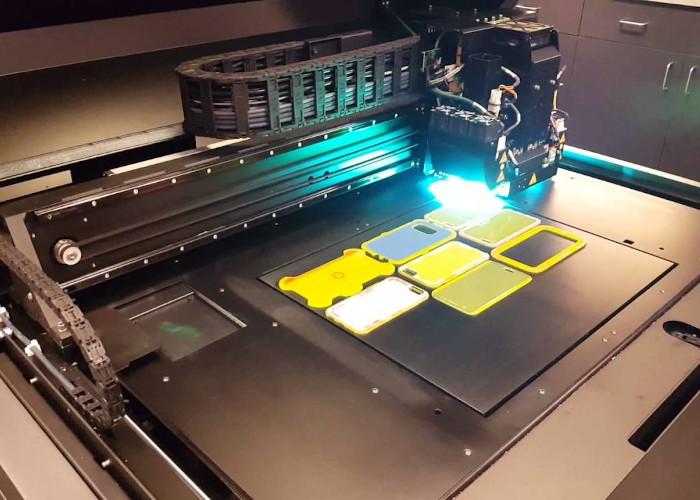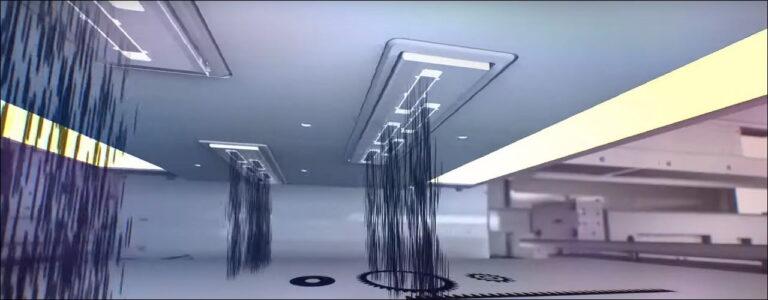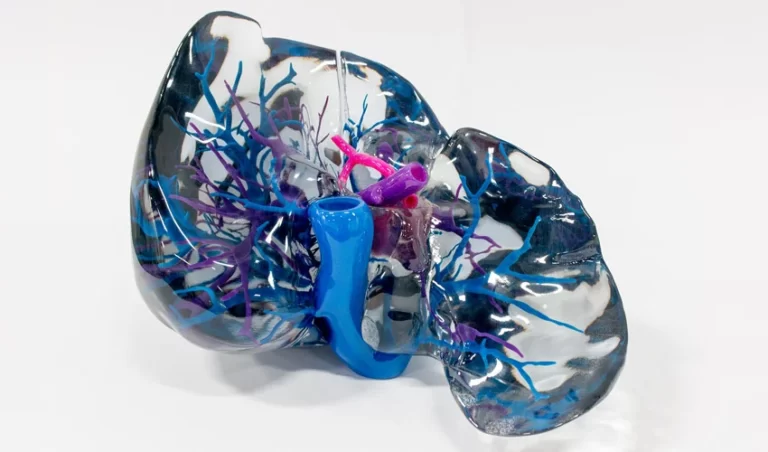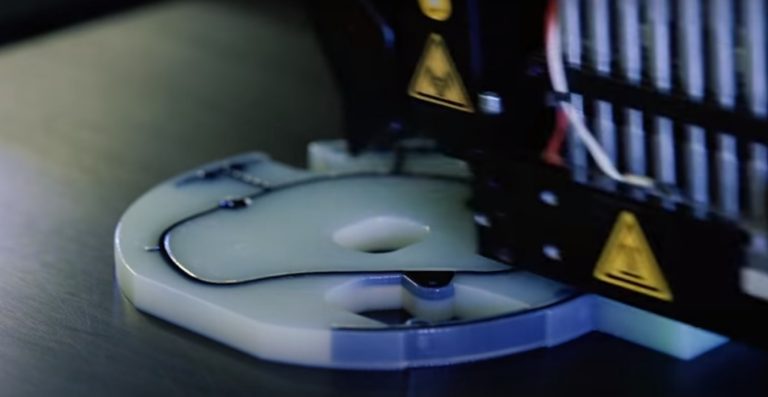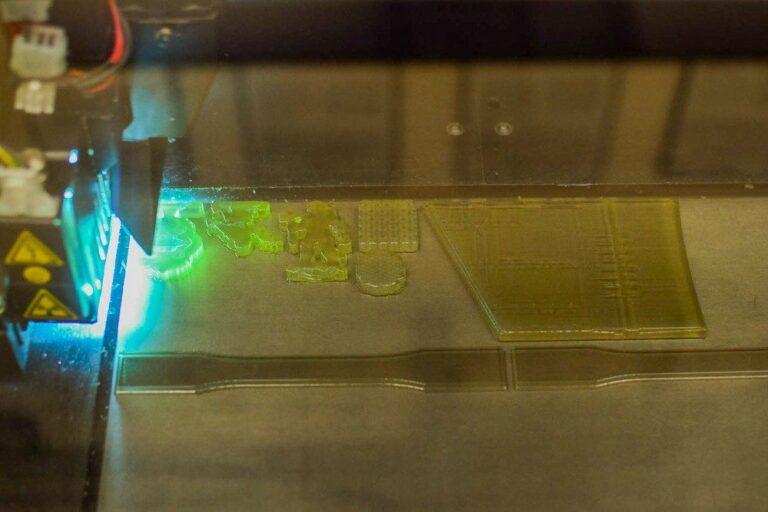Introduction
A brief overview of Material Jetting Technology (MJT)
Material Jetting Technology (MJT) has emerged as a groundbreaking 3D printing technique. It involves depositing tiny droplets of material in a layer-by-layer process, resulting in highly accurate and detailed objects. MJT has opened up new possibilities in various industries, thanks to its unique capabilities.
Importance of precision in modern manufacturing
Precision plays a crucial role in today’s manufacturing landscape. With the increasing demand for high-quality and intricate designs, MJT offers an unmatched level of accuracy. This precision is essential for creating complex structures, ensuring that even the most minor details are captured.
Purpose of the blog post
This blog post aims to provide an overview of Material Jetting Technology and its numerous benefits. We will discuss the technology in detail, highlighting its applications across industries, and exploring future developments. By the end, you will thoroughly understand MJT and its potential impact on the manufacturing world.
In the following sections, we will delve deeper into the workings of MJT, its advantages, and the wide range of applications it supports. By examining the technology’s capabilities and potential growth, we hope to shed light on the remarkable potential of Material Jetting Technology.
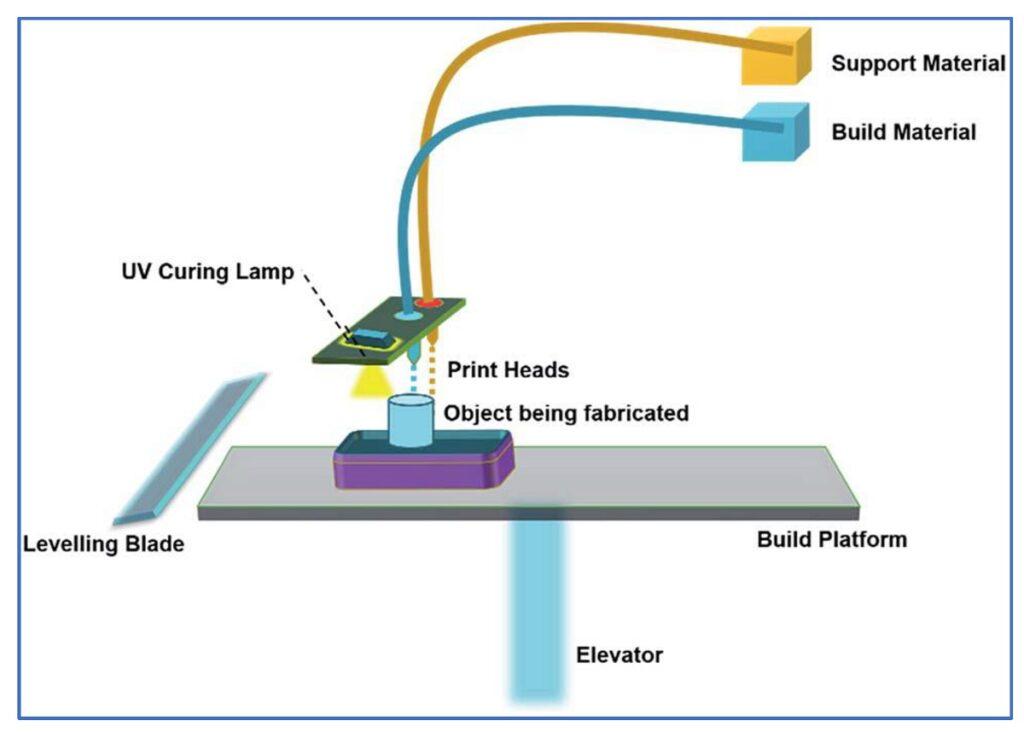
The Material Jetting Technology Explained
Definition and basic concept of MJT
Material Jetting Technology (MJT) is a 3D printing process that creates objects by jetting tiny droplets of material onto a build platform. Layer by layer, these droplets solidify, forming a precise and intricate structure. MJT stands out for its high resolution and ability to print with various materials, making it suitable for a wide range of applications.
Comparison with other additive manufacturing technologies
Comparing MJT with other additive manufacturing technologies reveals distinct advantages. For instance, Fused Deposition Modeling (FDM) and Stereolithography (SLA) are also popular 3D printing methods. However, MJT offers higher precision and a broader material selection than FDM, and faster printing times than SLA. These qualities position MJT as a top choice for many industries seeking cutting-edge manufacturing solutions.
Primary components and functioning of MJT
To understand the functioning of MJT, we must examine its primary components. First, the material cartridge stores the printing material, which is heated and prepared for jetting. Next, the printhead jets the material, controlled by sophisticated software, ensuring accurate deposition. Finally, the build platform supports the object as it takes shape, layer by layer. Together, these components work seamlessly to create high-quality, precise objects through Material Jetting Technology.
Advantages of Material Jetting Technology
Material Jetting Technology (MJT) offers several benefits that set it apart from other additive manufacturing methods. In this section, we will explore these advantages, highlighting how MJT enhances precision, material versatility, speed, and sustainability in the manufacturing process. Understanding these benefits can help businesses and industries make informed decisions when adopting advanced 3D printing technologies.
Precision and accuracy
1. High resolution and detail
Material Jetting Technology’s ability to produce high-resolution prints is one of its greatest strengths. By jetting tiny droplets of material, MJT creates objects with exceptional detail and surface finish. This level of precision results in aesthetically pleasing and functional end products, which are highly sought after in various industries.
The importance of high resolution and detail cannot be overstated, especially in industries like medical, electronics, and aerospace. MJT enables the production of intricate parts, components, and devices that are essential for the functionality and success of products in these fields.
2. Achieving complex geometries
MJT’s precision allows for the creation of complex geometries that would be difficult or impossible to achieve with other 3D printing methods. The technology’s layer-by-layer approach and precise material deposition make it possible to build objects with intricate internal structures and challenging external features.
The ability to produce complex geometries is invaluable in numerous applications. For example, in the aerospace industry, lightweight components with intricate internal lattice structures can significantly reduce fuel consumption. In the medical field, customized implants and prosthetics with unique geometries can improve patient outcomes. Thus, MJT’s capacity for producing complex geometries has broad implications across many industries.
Material versatility
1. Range of materials (polymers, ceramics, metals)
Material Jetting Technology stands out for its ability to process a wide range of materials. MJT supports printing with polymers, ceramics, and metals, offering a high degree of flexibility for various applications. This versatility makes MJT an ideal solution for industries with diverse material requirements.
Furthermore, the adaptability of MJT allows manufacturers to experiment with new materials and combinations, fostering innovation. Consequently, MJT has the potential to revolutionize various fields, such as automotive, aerospace, and medical, by offering tailored solutions for unique challenges.
2. Multi-material capabilities
In addition to its material range, MJT also excels in multi-material printing. This capability enables the creation of objects with different material properties within a single print, resulting in highly functional and customized products.
Multi-material capabilities open up new possibilities for product design, especially in fields requiring complex components. For instance, in the medical industry, multi-material 3D-printed prosthetics and implants can provide better comfort and fit for patients. Similarly, in the electronics sector, multi-material printing allows for the production of intricate components with diverse properties, such as electrical conductivity and thermal resistance. Overall, the material versatility of Material Jetting Technology paves the way for innovative solutions across industries.
Speed and efficiency
1. Reduced production time
Material Jetting Technology offers significant speed advantages over traditional manufacturing methods. By depositing material in a precise manner, MJT accelerates the production process, reducing the time required to create complex objects. Consequently, MJT enables faster prototyping and shorter production cycles.
Additionally, MJT’s speed benefits extend to industries requiring rapid manufacturing of custom components. For example, the medical and dental sectors can benefit from quick production of patient-specific implants, prosthetics, or dental restorations, ultimately improving patient care and outcomes.
2. Minimal post-processing requirements
Another advantage of Material Jetting Technology is its minimal post-processing requirements. MJT produces objects with smooth surface finishes, reducing the need for labor-intensive finishing processes like sanding, polishing, or machining. As a result, MJT streamlines production workflows and lowers overall production costs.
The reduced post-processing also contributes to MJT’s efficiency in producing ready-to-use parts. This characteristic is particularly beneficial for industries that demand intricate components, such as aerospace or electronics. By minimizing post-processing, Material Jetting Technology enables a more efficient, cost-effective, and environmentally friendly approach to manufacturing.
Environmental benefits
1. Reduced waste and material usage
Material Jetting Technology significantly reduces waste compared to traditional manufacturing methods. By depositing material only where it’s needed, MJT enables efficient usage of resources, leading to less material consumption and minimized waste generation.
Furthermore, MJT supports a more sustainable manufacturing approach by facilitating the reuse of excess material. Instead of disposing of surplus material, it can be reclaimed and reused in future production runs, contributing to a circular economy and reducing the environmental footprint of manufacturing processes.
2. Energy efficiency
Another environmental benefit of Material Jetting Technology is its energy efficiency. MJT typically requires less energy compared to traditional manufacturing methods, such as injection molding or subtractive techniques. This reduced energy consumption leads to lower greenhouse gas emissions and a smaller carbon footprint.
In addition to energy savings, the use of Material Jetting Technology can also contribute to the development of environmentally friendly products. For example, lighter components produced using MJT can lead to reduced fuel consumption in transportation applications. Overall, MJT promotes a more sustainable and eco-conscious approach to manufacturing, benefiting both businesses and the environment.
Applications of Material Jetting Technology
With a wide range of applications in numerous industries, Material Jetting Technology has emerged as a revolutionary invention in the manufacturing sector. The way goods are created and planned has the potential to undergo a revolution thanks to MJT’s accuracy, material variety, and environmental advantages. We will examine some of the most famous MJT applications in the sections that follow, showing how this cutting-edge technology is reshaping production and creating new opportunities for both companies and consumers.
Medical and dental industries
1. Custom implants and prosthetics
In the medical and dental industries, Material Jetting Technology has made a significant impact. One of its key applications is the creation of custom implants and prosthetics. With MJT, healthcare professionals can design and produce tailor-made solutions to fit individual patients’ unique anatomies, enhancing comfort and promoting better recovery.
2. Surgical tools and guides
Moreover, MJT has also proven valuable in the production of surgical tools and guides. The technology allows for the fabrication of precise, customized instruments that can improve surgical outcomes and reduce the risk of complications. In addition, using MJT for producing patient-specific surgical guides can help surgeons plan and execute complex procedures with greater accuracy and confidence.
Overall, Material Jetting Technology has revolutionized the medical and dental industries by offering personalized solutions and fostering advancements in patient care. As the technology continues to evolve, we can expect even more groundbreaking applications in these fields, paving the way for improved health outcomes and enhanced patient experiences.
Aerospace and automotive industries
1. Lightweight components
Material Jetting Technology has made substantial contributions to the aerospace and automotive industries. One notable advantage is the production of lightweight components. By employing MJT, manufacturers can create parts with intricate geometries and optimized designs, reducing the overall weight of vehicles and aircraft without sacrificing strength or performance. This weight reduction leads to increased fuel efficiency and reduced emissions, which are critical factors in these industries.
2. Rapid prototyping and functional testing
Furthermore, MJT has streamlined the rapid prototyping and functional testing process. Engineers can quickly create and evaluate design iterations, making adjustments as needed to achieve optimal results. This accelerated development process enables companies to bring new products to market more swiftly, enhancing their competitive edge. Additionally, Material Jetting Technology’s ability to produce fully functional prototypes allows for thorough testing and validation, ensuring the reliability and safety of the final products.
In conclusion, Material Jetting Technology has transformed the aerospace and automotive industries by facilitating the production of lightweight components and accelerating the design process. Its versatility and precision have made it a valuable tool for innovation, leading to improved performance, efficiency, and safety in these sectors.
Electronics industry
1. Circuit boards and components
Particularly in the manufacture of circuit boards and components, Material Jetting Technology has had a considerable impact on the electronics sector. MJT makes it possible to precisely create circuitry that is both very complicated and miniature. As technology advances quickly, this enables the creation of smaller, more potent electronic devices that are in high demand.
2. Custom enclosures and housings
The design and production of custom enclosures and housings for electrical equipment has also been revolutionized by Material Jetting Technology. With the capacity to print various materials at once, MJT can create enclosures with integrated electronics, cutting down on costs and assembly time. This enables the development of extremely unique designs that are suited to certain specifications and meet the varied needs of the electronics sector.
In conclusion, Material Jetting Technology has made a huge impact on the electronics sector by making it possible to produce complex circuit boards, components, and unique enclosures. Its high level of accuracy and adaptability have encouraged innovation and sped up the creation of smaller, more effective, and more potent electronic gadgets. MJT has shown to be a crucial tool for keeping up with the changing needs of this quick-paced industry.
Consumer products
1. Customized and intricate designs
Particularly in the fabrication of unique and elaborate designs, Material Jetting Technology has had a considerable impact on the consumer products sector. Manufacturers may create intricate geometries with excellent detail because to MJT’s high-resolution capabilities. Because of this, a wide range of consumer demands and preferences can be catered to by developing distinctive and new products.
2. Personalization and on-demand production
Furthermore, Material Jetting Technology has widened the accessibility of customization and on-demand manufacturing. Customers want more and more things that are customized to their specific tastes, and MJT offers a solution by making it possible to produce one-of-a-kind items without the need for expensive and time-consuming equipment. The ability to cater to specialized markets and offer a wider choice of options thanks to this on-demand production strategy eventually leads to higher customer satisfaction.
In summary, Material Jetting Technology has revolutionized the consumer goods sector by enabling the manufacture of distinctive, detailed designs and enabling on-demand manufacturing. Due to its distinctive capabilities, businesses are now able to provide personalized, innovative products that were previously difficult or impossible to produce using conventional manufacturing techniques, as well as cater to the varied needs of consumers.
Future Developments in Material Jetting Technology
The world of additive manufacturing is witnessing rapid advancements, and Material Jetting Technology (MJT) stands at the forefront of these innovations. As industries increasingly adopt MJT for its versatility, precision, and efficiency, the potential for future developments in this technology is immense. This article will explore the promising prospects of Material Jetting Technology, delving into innovations in material properties, integration with other manufacturing methods, and expansion into new industries and applications. Join us as we uncover the exciting future of MJT and its transformative impact on the manufacturing landscape.
Innovations in material properties and capabilities
As Material Jetting Technology continues to evolve, innovations in material properties and capabilities are anticipated. Researchers are working on developing new materials with improved mechanical, thermal, and chemical properties to further expand the potential applications of MJT. With these advancements, more industries will be able to benefit from the versatility and precision that MJT offers, resulting in a broader range of products and solutions.
Integration with other manufacturing technologies
Another area of development in Material Jetting Technology involves its integration with other manufacturing technologies. Combining MJT with traditional methods, such as injection molding or CNC machining, can help optimize the production process and create even more complex and functional parts. This hybrid approach allows manufacturers to leverage the strengths of different techniques, resulting in increased efficiency and more cost-effective production.
Expansion into new industries and applications
Lastly, Material Jetting Technology is poised to expand into new industries and applications. As the technology matures and becomes more accessible, it will likely find its way into sectors that have not yet fully embraced additive manufacturing. This expansion will further demonstrate the versatility and potential of MJT, opening doors to novel applications and driving continued innovation in the field.
In summary, the future of Material Jetting Technology looks bright, with ongoing advancements in material properties, integration with other manufacturing techniques, and expansion into new industries and applications. These developments promise to unlock even greater potential for MJT, solidifying its role as a transformative force in the world of manufacturing.
Conclusion
Recap of the benefits of Material Jetting Technology
In conclusion, Material Jetting Technology has demonstrated numerous benefits, including speed, efficiency, and environmental advantages. Additionally, it has found diverse applications across various industries, such as medical, aerospace, automotive, and consumer products.
The potential impact on manufacturing and innovation
The potential impact of MJT on manufacturing and innovation is considerable. With ongoing developments in material properties, integration with other manufacturing technologies, and expansion into new industries, MJT is set to revolutionize the manufacturing landscape.
Encouragement for further exploration and adoption of MJT
Lastly, we encourage businesses and researchers to further explore and adopt Material Jetting Technology. By embracing this cutting-edge technology, companies can stay ahead of the curve, optimize production processes, and foster innovation. Ultimately, MJT holds the key to unlocking a more efficient, sustainable, and customizable future for manufacturing.
How to incorporate Material Jetting Technology into your existing manufacturing process?
- Assess Your Needs Description
Determine the specific applications and goals you aim to achieve with Material Jetting Technology. Identify areas where MJT can add value, such as reducing lead time, improving customization, or creating intricate designs.
- Research Compatible Equipment and Materials Description
Investigate Material Jetting Technology equipment that is compatible with your current manufacturing process. Research materials that meet your requirements in terms of strength, flexibility, and desired finish.
- Train Your Team Description
Ensure your team is well-trained in Material Jetting Technology, including operation, maintenance, and troubleshooting. Utilize online resources, workshops, or vendor-provided training to gain the necessary knowledge.
- Optimize Your Designs Description
Adapt and optimize your product designs for MJT, taking into consideration factors like material properties, support structures, and build orientation to achieve the desired outcome.
- Integrate MJT Equipment into Your Workflow Description
Incorporate the Material Jetting Technology equipment into your existing manufacturing setup, ensuring smooth integration with other machines, software, and processes. Establish efficient workflows and communication between different departments.
- Test and Validate Description
Conduct testing and validation of products created with MJT. Verify that the parts meet required specifications, tolerances, and quality standards. Adjust the process as necessary to achieve optimal results.
- Monitor and Optimize the Description
Continuously monitor and evaluate the performance of Material Jetting Technology in your manufacturing process. Gather feedback from your team and customers, and implement improvements to further enhance efficiency and quality.
FAQs
Material Jetting Technology can work with a wide range of materials, including photopolymers, wax, ceramics, and metals. The choice of material depends on the specific application, desired properties, and equipment compatibility.
Material Jetting Technology uses printheads to deposit droplets of material onto a build platform, creating parts layer by layer. This method provides high resolution and accuracy and allows for multi-material printing. It differs from other techniques like Fused Deposition Modeling (FDM) or Selective Laser Sintering (SLS), which use filament extrusion or powder sintering, respectively.
While MJT is primarily used for rapid prototyping, low-volume production, and complex geometries, it can be utilized for mass production in specific cases. Factors like cost, material properties, and production speed should be considered to determine if MJT is the right choice for your application.
Material Jetting Technology has applications across various industries, including aerospace, automotive, medical, dental, electronics, and consumer products. It is particularly useful for industries requiring high levels of customization, intricate designs, or lightweight components.
MJT offers several environmental benefits, such as reduced waste, lower material usage, and energy efficiency. By producing parts on-demand and with greater precision, MJT can minimize material waste and contribute to a more sustainable manufacturing process.

